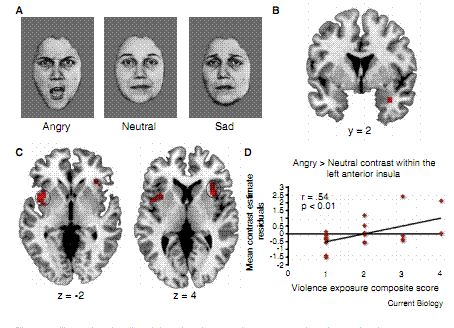受虐待儿童与战争中的士兵有相同的大脑活动模式
译者 阎兰
来自: 安娜弗洛伊德研究中心
暴露在家庭暴力环境下的儿童的脑区活动模式与暴露在战场的士兵的脑区活动模式有一致性。
这是首次为探讨身体虐待和家庭暴力对儿童的影响的MRI大脑扫描研究,由UCL的科学家与安娜佛洛伊德中心合作。研究发现,当让儿童看愤怒的脸的照片时,有家庭暴力的儿童的大脑活动在两个特定的脑区(前脑岛和杏仁核) 有明显的增加。
先前的fMRI研究表明,暴露在作战形势下的士兵大脑扫描结果表现出这两个脑区相同模式的高激活状态,这与感受到威胁有关。作者认为这可能是因为受虐待的儿童和士兵们适应了对环境危险保持高敏感度。
然而,前脑岛和杏仁核区域的过度活动也常常暗示是有焦虑症的表现。在这些脑区的神经适应也许有助于解释为什么孩子暴露于家庭暴力会在未来的生活中更有可能患上焦虑症等其他诸多问题。
文章的第一作者Eamon McCrory博士(UCL心理语言科学系和安娜佛洛伊德研究中心研究员)说:“我们现在才开始了解受虐待儿童的大脑功能如何影响他们的情感系统。本研究是很重要的,因为它提供了我们的第一个线索揭示儿童的大脑可以如何适应早年的家庭暴力。”
McCrory博士补充说:“接受研究的儿童都是健康的,没有精神健康问题。我们的研究显示出儿童暴露于家庭暴力会伴随着脑功能改变,同时并没有明显的精神症状,这些脑区活动的改变可以代表一个潜在的神经危险因素。我们认为这些变化可能使儿童可以在短期内适应环境,但却可能增加了长期的风险”。
此项研究发表在《现代生物学》期刊上,有43名的儿童被试接受了fMRI脑部扫描。其中20名儿童曾遭受家庭暴力,与之匹配的同龄的23名儿童被试没有经历过家庭暴力。受虐待的儿童被试的平均年龄是12岁,他们目前受伦敦当地的社会服务保护。
给儿童看不同男性、女性悲伤、平静或愤怒的面部表情照片,同时对他们进行fMRI扫描。尽管照片上的人的面部表情不同,并且是随机播放的,但儿童只需说出他看到的照片是男性还是女性。实验结果如前文提到的,当暴露于家庭暴力的儿童看到愤怒表情的脸孔时,大脑的前脑岛和杏仁核区域有明显地激活。
Fonagy Peter 教授(安娜佛洛伊德中心负责人,UCL心理学教授)说:“McCrory博士开创性的研究无疑将我们对受虐待儿童的了解拉近了重要的一步,并对仍然处于暴力中的家庭敲响了警钟。他的实验结果证实了这些受虐待经验对大脑发育有创伤性地影响。”
Fonagy教授补充说:“这个报告提示应该加强临床医生和社会工作者在保障儿童远离家庭暴力方面的工作力度。同时这个研究也帮助我们了解受虐待儿童的创伤所在,以便我们有针对性地发展有效的治疗策略,保护儿童免遭受虐待后的长期隐性后果。”
McCrory博士说:“即使现在我们知道了虐待是一个最有力的环境危险因素,它与焦虑和抑郁有关,但我们仍然不知道这样的逆境产生的‘皮肤之下的创伤’对儿童未来的精神问题易感性有怎样的影响。”
“对我们来说下一步就是尝试去理解这些变化是否稳定。并不是每个暴露在家庭暴力中的孩子将来都会发生心理健康问题,许多儿童有很强的恢复力,并且拥有成功的生活。我们想对这些机制有更多的了解,以帮助儿童更好地恢复。”
本文原文:译者 阎兰
Maltreated children show same pattern of brain activity as combat soldiers
http://www.sciencedaily.com/releases/2011/12/111205140406.htm
5 December 2011
Children exposed to family violence show the same pattern of activity in their brains as soldiers exposed to combat, new research has shown.
Listen to an interview with Dr McCrory on the BBC World Service.
In the first functional MRI brain scan study to investigate the impact of physical abuse and domestic violence on children, scientists at UCL in collaboration with the Anna Freud Centre, found that exposure to family violence was associated with increased brain activity in two specific brain areas (the anterior insula and the amygdala) when children viewed pictures of angry faces.
Previous fMRI studies that scanned the brains of soldiers exposed to violent combat situations have shown the same pattern of heightened activation in these two areas of the brain, which are associated with threat detection. The authors suggest that both maltreated children and soldiers may have adapted to be ‘hyper-aware’of danger in their environment.
However, the anterior insula and amygdala are also areas of the brain implicated in anxiety disorders. Neural adaptation in these regions may help explain why children exposed to family violence are at greater risk of developing anxiety problems later in life.
Dr Eamon McCrory, lead author from the UCL Division of Psychology and Language Sciences and the Anna Freud Centre, said: “We are only now beginning to understand how child abuse influences functioning of the brain’s emotional systems. This research is important because it provides our first clues as to how regions in the child’s brain may adapt to early experiences of abuse in the home."
Dr McCrory added: “All the children studied were healthy and none were suffering from a mental health problem. What we have shown is that exposure to family violence is associated with altered brain functioning in the absence of psychiatric symptoms and that these alterations may represent an underlying neural risk factor. We suggest these changes may be adaptive for the child in the short term but may increase longer term risk”.
In the study, which is published in the journal Current Biology, 43 children had their brains scanned using an fMRI scanner. 20 children who had been exposed to documented violence at home were compared with 23 matched peers who had not experienced family violence. The average age of the maltreated children was 12 years old and they had all been referred to local social services in London.
When the children were in the scanner they were presented with pictures of male and female faces showing sad, calm or angry expressions. The children had only to decide if the face was male or female – processing the emotion on the face was incidental. As described, the children who had been exposed to violence at home showed increased brain activity in the anterior insula and amygdala in response to the angry faces.
Professor Peter Fonagy, Chief Executive of the Anna Freud Centre and professor of psychology at UCL, said: “Dr McCrory's groundbreaking research has undoubtedly taken us an important step closer to understanding the devastation which exposing children to violence can leave in its wake. His exciting findings confirm the traumatic effects these experiences have on brain development.
Professor Fonagy added: “The report should energize clinicians and social workers to double their efforts to safeguard children from violence. By helping us understand the consequences of maltreatment the findings also offer fresh inspiration for the development of effective treatment strategies to protect children from the consequences of maltreatment."
Dr McCrory said: “Even though we know that maltreatment represents one of the most potent environmental risk factors associated with anxiety and depression, relatively little is known how such adversity 'gets under the skin' and increases a child's later vulnerability.”
“The next step for us is to try and understand how stable these changes are. Not every child exposed to family violence will go on to develop a mental health problem; many bounce back and lead successful lives. We want to know much more about those mechanisms that help some children become resilient.”
The research was funded by the Economic and Social Research Council.
http://download.cell.com/current-biology/pdf/PIIS0960982211011390.pdf?intermediate=true
Journal Reference:Eamon J. McCrory, Stéphane A. De Brito, Catherine L. Sebastian, Andrea Mechelli, Geoffrey Bird, Phillip A. Kelly, Essi Viding. Heightened neural reactivity to threat in child victims of family violence. Current Biology, 2011; 21 (23): R947-R948 DOI: 10.1016/j.cub.2011.10.015
http://download.cell.com/current-biology/pdf/PIIS0960982211012000.pdf?intermediate=true
http://www.bbc.co.uk/iplayer/console/p00lxb9w

